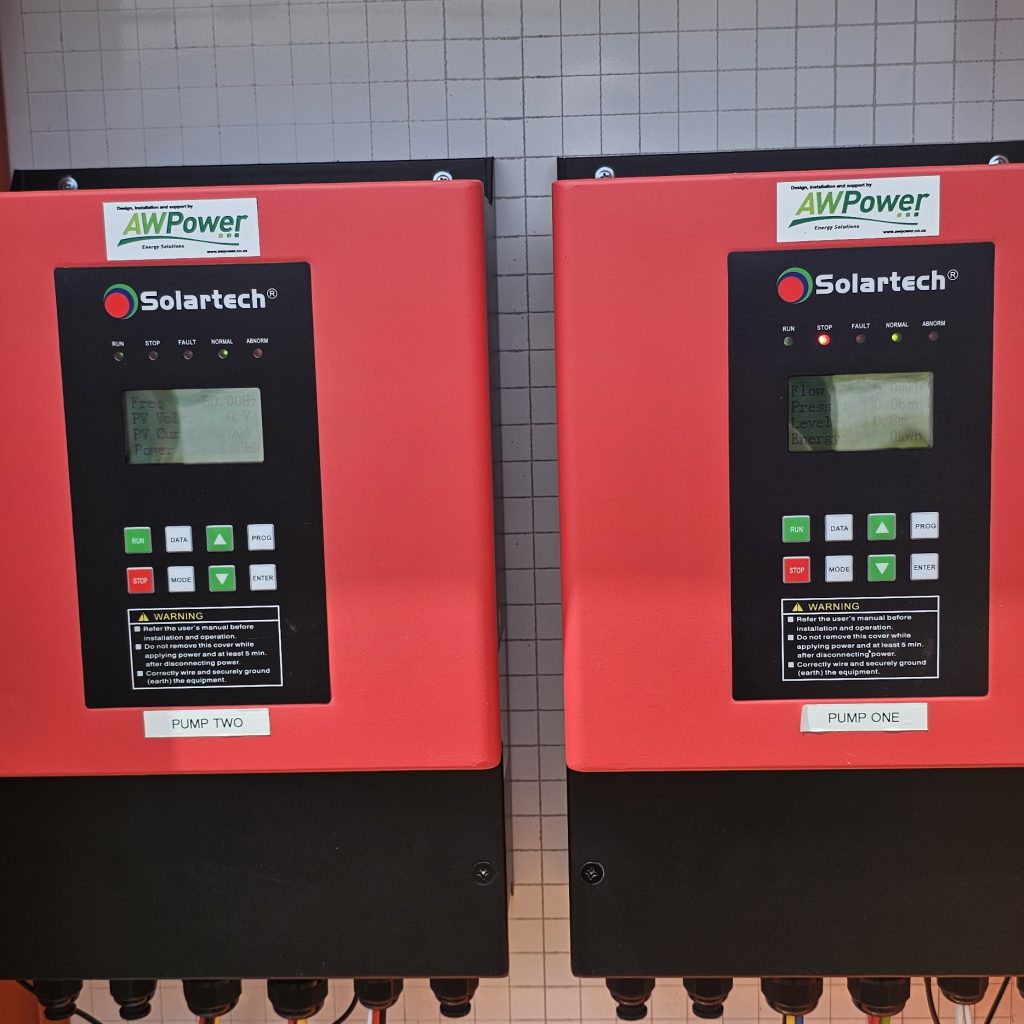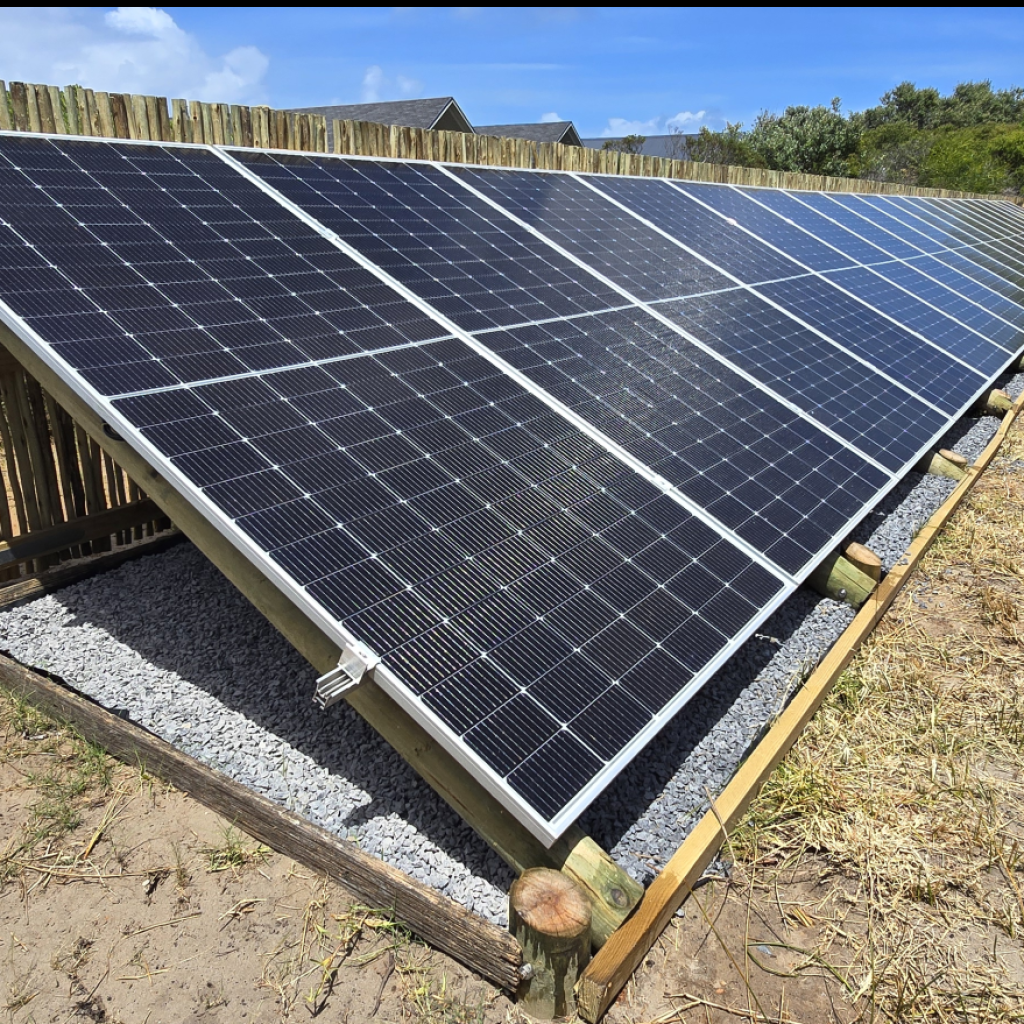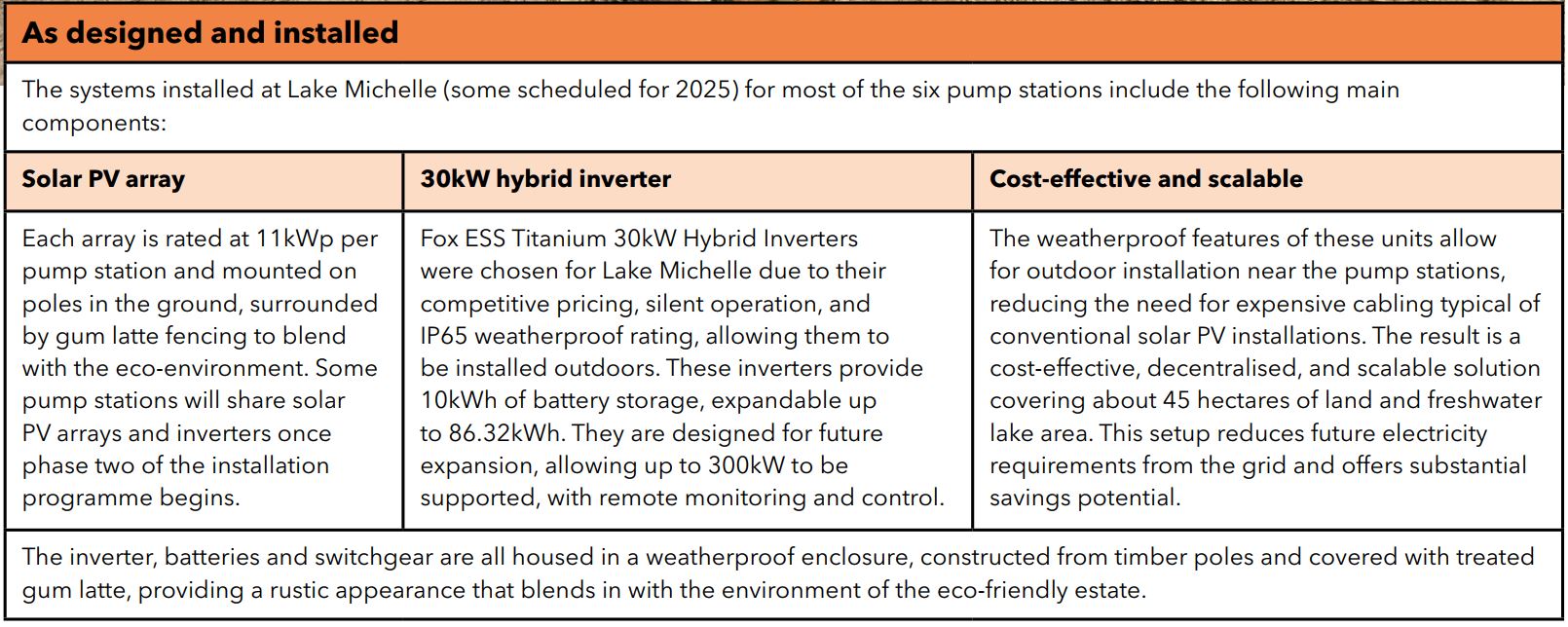By Gareth Griffiths, Photos by AWPower
AWPower, a renewable energy company based in Cape Town, tells TO BUILD that its engineers and members of Lake Michelle’s Alternative Energy Committee, have successfully designed, tested, and implemented a decentralised solar system to address the estate’s critical infrastructure needs.
Lake Michelle is a gated residential complex situated within the lake area of the Noordhoek Valley, Cape Town.
This system supports the administrative building, security systems, and six sewage pump stations. By designing a decentralised solution, substantial savings have been realised compared to a large centralised system. This approach also offers significant room for future upgrades and expansion.
Primarily, these systems support the estate’s sewage pump stations with solar-generated power. Each sewage pump is fitted with a dynamic solar pumping inverter to manage and automate its operation, as well as to provide full digital remote management and control capabilities. Solar-generated power also supports several high-capacity water pumps that move water between the main lake and ponds to maintain water quality.
At its peak during summer, when excess generated power can be exported to the grid, each decentralised solar system will save around R5 500 per month at the current electricity cost, achieving a payback period of fewer than four years, according to the company.
Set against the backdrop of Lake Michelle’s pristine 22-hectare freshwater lake, the supplier’s “Out of Africa” solution not only meets the estate’s sustainability goals but also ensures a reliable and efficient water management system.

Challenges for eco estates
Eco estates in environmentally sensitive areas such as Lake Michelle run the risk of grid-electric sewage pump failure, which could prevent sewage removal from the property. In the case at hand, the infrastructure consists of six pumping stations in series. In the absence of grid power to drive the pumps, or should they fail, the risk of polluting the freshwater lake with effluent would have a disastrous effect on the environment, including its diverse birdlife, fish, and wildlife.
Before the upgrade, each pumping station was equipped with two 3-phase 5kW submersible pumps, controlled by an array of switchgear. The fluid level in the sewage chambers was measured by float switches submerged in the sewage chambers or sump. Should this malfunction or become clogged with fatty deposits, the system would activate an alarm, signalling the need for maintenance intervention. This could occur at any time, especially after a heavy downpour when sewage chambers are more prone to overloading.
A challenge for maintenance staff was the lack of insight into the actual level of the sewage chambers or the condition of the switchgear and pumps unless they physically opened the hatches and checked the levels. If a component failed in the traditional pump station, the first sign could be a sewage spill into the surrounding area – something familiar to many South Africans who see their local councils struggle with such issues.
The solution
AWPower conducted international research into the modernisation and effective management of pumping stations. Solartech was recommended as a leading manufacturer of solar pumping inverters. A prototype system was designed to replace the traditional pump station switchgear and after several months of testing, a final pump inverter-based system was developed to replace the old mechanical systems consisting of float switches and complex switchgear.
The solar pumping inverter replaces all the functions of the traditional pump station switchgear, offering cloud-based remote monitoring and control as a cost-effective and reliable solution for Lake Michelle. The inverter connected to the sewage pump becomes the “brain” of the submersible pump, turning it into a fully digitised and programmable solution. It measures the level in the sewage sump, switches the 3-phase submersible pumps on or off, and can run the pumps alternately or together if the sump level is abnormally high.

As designed and installed
The systems installed at Lake Michelle (some scheduled for 2025) for most of the six pump stations include the following main components:
- Solar PV array
Each array is rated at 11kWp per pump station and mounted on poles in the ground, surrounded by gum latte fencing to blend with the eco-environment. Some pump stations will share solar PV arrays and inverters once phase two of the installation programme begins.

- 30kW hybrid inverter
Fox ESS Titanium 30kW Hybrid Inverters were chosen for Lake Michelle due to their competitive pricing, silent operation, and IP65 weatherproof rating, allowing them to be installed outdoors. These inverters provide 10kWh of battery storage, expandable up to 86.32kWh. They are designed for future expansion, allowing up to 300kW to be supported, with remote monitoring and control. - Cost-effective and scalable
The weatherproof features of these units allow for outdoor installation near the pump stations, reducing the need for expensive cabling typical of conventional solar PV installations. The result is a cost-effective, decentralised, and scalable solution covering about 45 hectares of land and freshwater lake area. This setup reduces future electricity requirements from the grid and offers substantial savings potential.
The inverter, batteries and switchgear are all housed in a weatherproof enclosure, constructed from timber poles and covered with treated gum latte, providing a rustic appearance that blends in with the environment of the eco-friendly estate.
7.5kw solar pumping inverters
Each pump station is equipped with two Solartech pump inverters, each with a 6m liquid level sensor submerged into the sewage chamber, connected to a sewage pump. Although the pump inverters are IP65-rated, they are housed in IP65 rated boxes to provide extra protection for switchgear mounted inside, together with pump inverters. Coloured orange, these are mounted to the back of the previous generation black switchgear kiosks. The two boxes are mounted back-to-back on top of the sewage chamber. Each pump inverter is equipped with a communications module with a SIM card that facilitates remote monitoring and control of each of the two sewage pumps with matching solar pumping inverters, providing a fully digitised solution allowing access to managed functions via a keyboard and screen for maintenance staff.
Being a fully digitised and simplified solution with fewer moving parts, all information on pump station status is available on a mobile device or laptop PC with a large screen for security staff to watch. A monitoring dashboard that will keep security and maintenance staff members fully informed, without leaving their office or home was developed by the supplier. This collects data from a cloud-based solution where data from each pump connected to a pump inverter, is stored and made available 24/7.


Direct savings generated
Energy security is greatly improved in the event of load shedding or grid failure, while cost savings from the grid by using solar power to support all the systems are expected to be significant.The interim data from the remote monitoring app for the Fox ESS 30kW system supporting Pump Station 3 (Milkwood) for November 2024 provides the following insights:
- Energy consumed during November 2024: 1.8MWh
- Energy purchased from the grid: 294.0kWh
- Self-sufficiency: 1.5MWh
Savings generated in November at R3.00/kWh = 1.5MWh x 1 000 x R3.00 = R4 500 (incl. VAT) savings for November 2024.
Once exported to the grid is approved and the relevant equipment installed by the City of Cape Town, Pump Station 3 could be expected to export at least 30kWh per day, for example, in November, which would yield further savings of approximately:
30kWh x 30 days x R1.1713 = R1,054 savings per month.
Typical November savings: R4 500 + R1 054 = R5 554.
Lower savings are expected during the winter months.
“In South Africa, we need to urgently optimise water usage, particularly in pump station management”, comments. Henri Hattingh, the Executive Chair of AWPower. “A similar decentralised and innovative approach could be applied to most residential and commercial estates, golf courses, and farming communities, paving the way towards a more sustainable future.”
Performance summary




